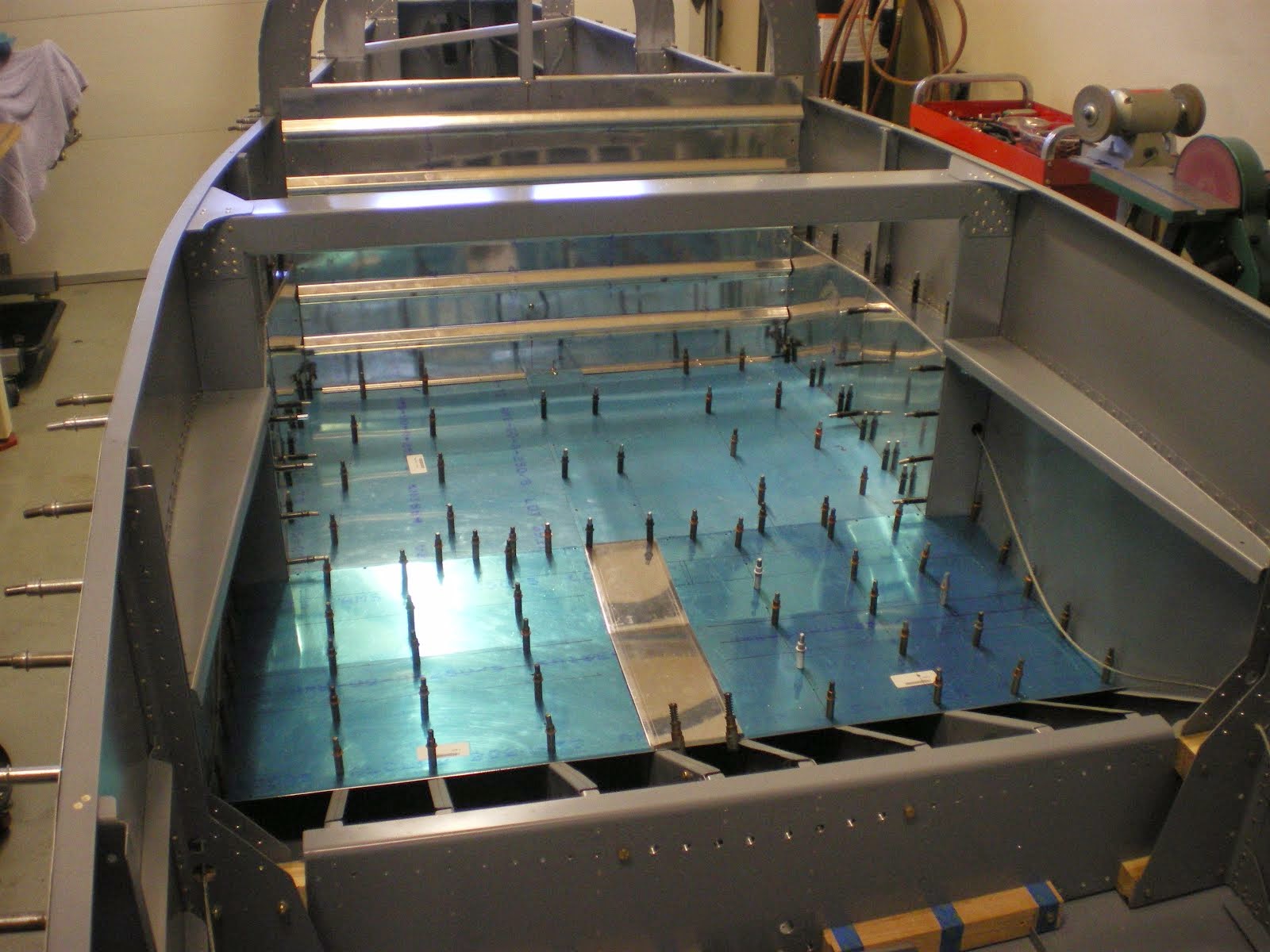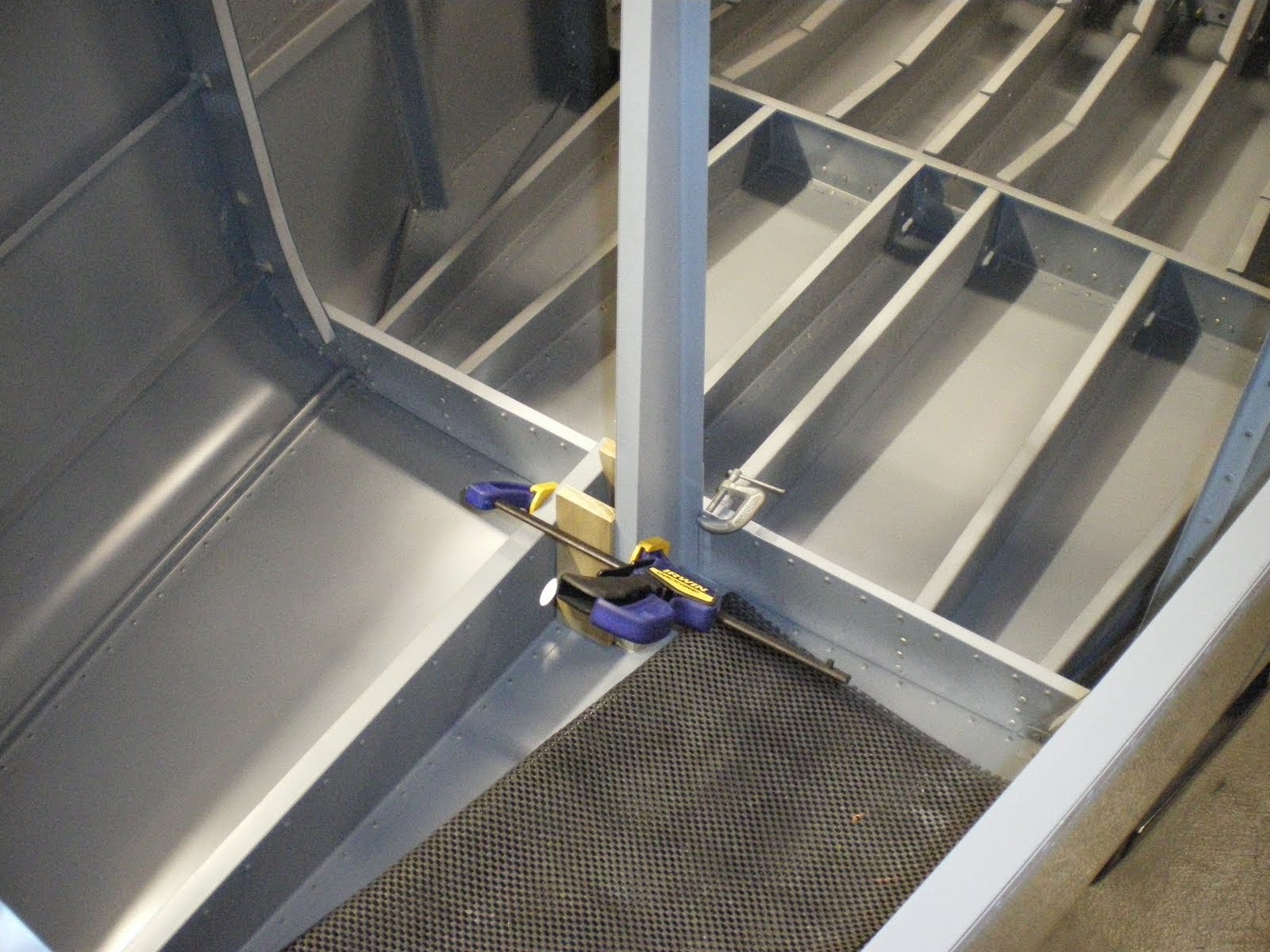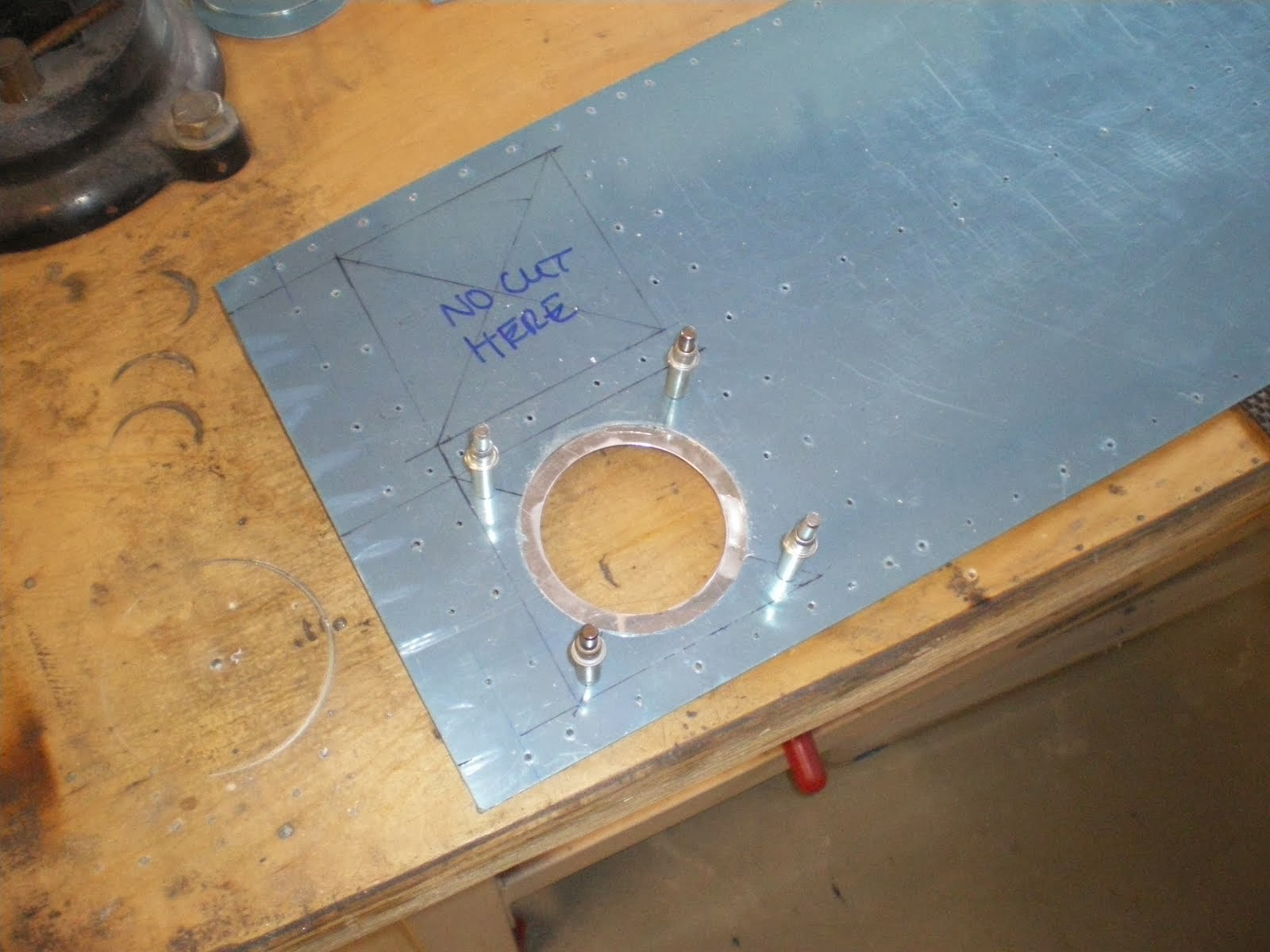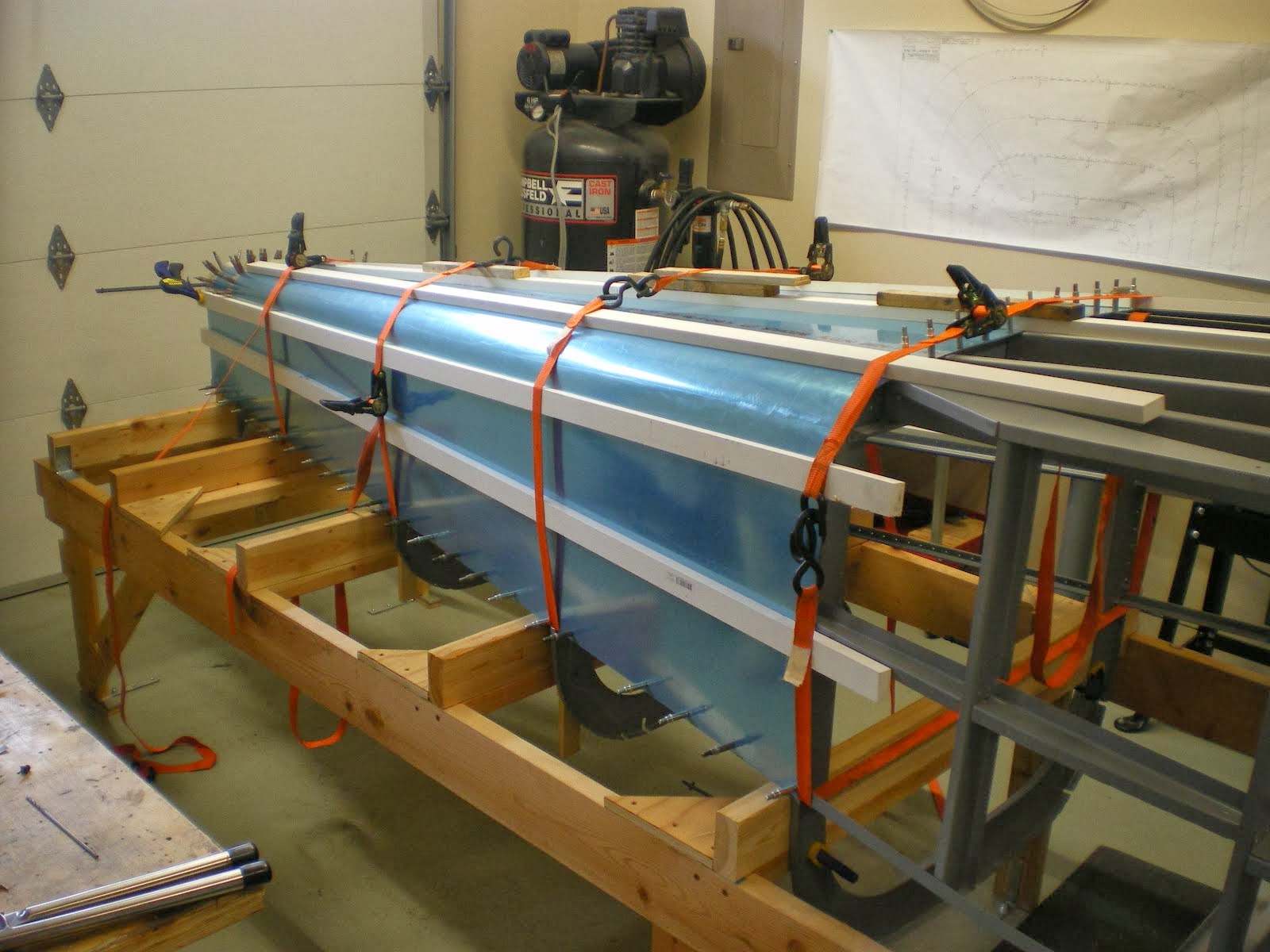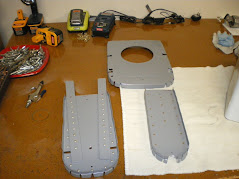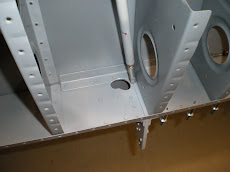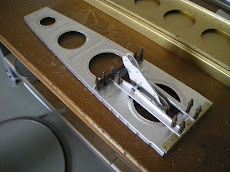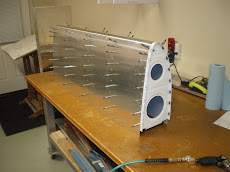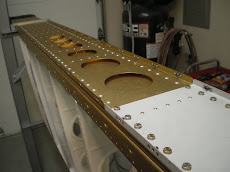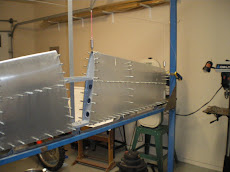I was reading through the ECi supplements and I came across one for the oil pump body. It says that the little hole on the side of the pump needs to be plugged up if you don't have fuel pump gears to lubricate. For the life of me, I cannot remember if I checked that or not. I took pics of the pump but only when it was mounted on the assy case and safetied wired. So I decided to take the assy case of and double check. It only took about a half hour to get the parts off the assy case and sump off. I double checked the pump and there was no hole at all so I was in the clear. Now I am telling you all of this because this is a lesson in learning to build engines. I would rather spend a half day pulling apart my engine to double check something just to be sure than spend the rest of my life dead because I have my pride. Swallow your pride and get out the wrenches. My family will be flying with me and I need to have that confidence that I did everything right. I put all of the parts back on the engine and I have peace of mind. I also read through all of there bulletins and checked to make sure there was nothing else that I missed.
I am still waiting on my spring compressor to arrive and small flap wheel so I can finish polishing those ports in the hard to reach areas. I also am trying to figure out how the valve springs go on the cylinder heads. There is a inner and outter valve spring and there is a top and bottom to the spring itself. It's very hard to tell, but they said the double coil is supposed to go towards the bottom. Now maybe I am not seeing this but there is not double coil. The only difference I can see is that one of the sides is not as tapered down as the other. Called ECI and sent a picture so they could inform me which way it goes. They seem to be very helpful and are working on it as I write this blog. I will get back and let you know what is going on. A picture is posted to let you decide what is up and what is down.
Monday, July 28, 2008
Thursday, July 24, 2008
Fitting all of the fittings--Son of a #@%&$
Part of the fun of putting together your own engine is finding out what does not want to fit. I am working on the oil cooler bypass fittings and the tach drive. I used the oil cooler bypass fittings before in my other RV-6. It's a special banjo fitting with special seal washers to seal the two sides of the banjo fitting. There are several reasons to use this style of fitting. One is that is can be rotated 360 degrees. So making oil lines fit up to it is very easy. The other is keeping all of the fittings up near to the top of the engine where they can be seen. The other oil line plug is down between the mags and is a little harder to get it. Plus it's more oil line to route and weighs more. The downside to using the banjo fitting is that it's a special thread 5/8-16. They is a special Cessna fitting that can be purcahsed if you don't mind paying 150 bucks for it. I have gotten surplus fittings from the days of old from Jesse at AERO. I cannot use the fitting since it's too close to the oil filter housing. The 90 degree oil filter solves one problem but creates another. I also have an issue with the Van's Tach that I am trying to use. I got the kind for the engine that is for ones without vacuum pumps. I will have to get one for ones with vacuum pumps that is a cable and mounts on the firewall. I had this on my last airplane and it works. It's just one more thing to mount of the firewall. I have also installed the new oil line fitting that goes in between the mags. I will use this one (as most others do as well) to supply oil to my cooler. I have also installed the 5/16 studs for the fuel injection servo on the sump. Studs are used here becasue there is no room for bolts. I have also finished polishing my ports on the cylinder heads for now. I am waiting for some smaller flap wheels to come in so I can get in there in the tight places. I will try and post some pics of the problems I face tomorrow.
Wednesday, July 23, 2008
Putting the mag gears on.
I tried to install one of the mag gears on the mag that has the impulse coupling on it. I took off the nut and went to put on the gear when the impulse coupling came up and unwound a couple of turns. This thing is spring loaded and there is a correct number of convolutions to keep the exact amount of tension on the impulse coupling. A quick call to my Dad and he had a overhaul book for Slick mags. I will get this from him when he comes up to help me get the cylinders on. Trying to get the gears torqued down while keeping them from spinning is going to be hard. There is a pin that comes with the mag but that is to hold the mag gear from moving after you have it timed and are installing it into the engine. It is not sturdy enough for me to torque it. More to follow.
Working on the cylinders
I started working on the cylinders. I have painted the top aluminum heads silver. I used the 3M cup system to spray the cylinders so that I could paint upside down. It worked ok but the paint came out in blotches. I had to take a brush and brush out the heavy spots. I thinned the paint down with reducer but it was not enough. It says 20% but it should be more like 30% and use a fast reducer.
After the top was painted I started on the bottom. Having problems with the top I had the local paint shop put some of my enamel in a spray can. They take my paint and put it in a spray can. It already has the solvents in it and it makes clean up a snap. I masked off the top and the lower portions so paint would not get on then and then took the cylinders outside and spray each one individually. They came out nice.
Next I am doing some grinding on the intake and exhaust ports. I have taken pictures of the sand casting in the ports and some of it is pretty rough. I have gotten cylinders from Ly-Con before and there porting is a work of art. They also produce the power as well. I just wanted to grind out imperfections and blend it all smooth. I could not reach all of the areas as you have to have some special grinding wheels to get in all of tight spots. I got about 80% of each port. I also had to be careful not to grind the seat for the valves. That would be very very bad. After I ground each cylinder I would clean it up and then lap the valves to the seats.
I talked with Ken Tunnel once about porting cylinders. He said all of his dyno testing indicated that the Lycoming cylinder worked out the best for porting. It always made more power. He has done Superior and ECI and indicated they never made the same power as Lycoming. I was in the shop one day getting my cylinders and he had a set ready to go for Sean Tucker for his Oracle bi-plane. They were Lycoming. Not saying ECI is bad, but something about there port design does not let the air flow the same. Call it BS but he has hard dyno testing to prove it. My cylinders with all of the mods to the engine should get me over 190 hp. If it puts out 195 with the 4-1 exhaust and the ram air cowling, I would be really happy.
I read up on lapping valves and there is not much too it. I purchased all of the items to lap valves at the local auto shop for about 20 bucks. You get some fine lapping compound, a lapping tool which is two suction cups on a stick, and a buncn of rags. I used some hose and extended the lapping tool so that it would stick up out of the cylinder a ways.
The valves in the cylinder cannot be mixed up. One is big (intake) and one is small (exhaust). I installed one on the end of the lapping tool, put compound on the seat of the valve , greased the stem and then installed it in the cylinder. I then set the cylinder up on the bench (inverted) let it lean against my chest. I then would spin the lapping tool back and forth like you are trying to start a fire. You need to hold a little down pressure as well. You can hear the valve lapping as it grinds. The grinding will start to go away and you will hear more of a smearing noise (you can feel it as well). This tells you that the valve is lapped and it completely seated in the valve seat. Take the valve out and clean it all up. Clean the seat as well. I then marked the cylinder a color and the both valve went into a valve box that was also marked the same color. This system will keep me from mixing up vavles cylinder to cylinder. Also when you look at the valves, you can see a slight graying of the valve where it hit the seat. The lapping compound it black and this help dye the area as it is ground down.
I purchased a Lycoming valve spring compressor from US Tools for 60 bucks. When I get that I will start putting the cylinders together for good and mounting them on the lower half of the engine.
After the top was painted I started on the bottom. Having problems with the top I had the local paint shop put some of my enamel in a spray can. They take my paint and put it in a spray can. It already has the solvents in it and it makes clean up a snap. I masked off the top and the lower portions so paint would not get on then and then took the cylinders outside and spray each one individually. They came out nice.
Next I am doing some grinding on the intake and exhaust ports. I have taken pictures of the sand casting in the ports and some of it is pretty rough. I have gotten cylinders from Ly-Con before and there porting is a work of art. They also produce the power as well. I just wanted to grind out imperfections and blend it all smooth. I could not reach all of the areas as you have to have some special grinding wheels to get in all of tight spots. I got about 80% of each port. I also had to be careful not to grind the seat for the valves. That would be very very bad. After I ground each cylinder I would clean it up and then lap the valves to the seats.
I talked with Ken Tunnel once about porting cylinders. He said all of his dyno testing indicated that the Lycoming cylinder worked out the best for porting. It always made more power. He has done Superior and ECI and indicated they never made the same power as Lycoming. I was in the shop one day getting my cylinders and he had a set ready to go for Sean Tucker for his Oracle bi-plane. They were Lycoming. Not saying ECI is bad, but something about there port design does not let the air flow the same. Call it BS but he has hard dyno testing to prove it. My cylinders with all of the mods to the engine should get me over 190 hp. If it puts out 195 with the 4-1 exhaust and the ram air cowling, I would be really happy.
I read up on lapping valves and there is not much too it. I purchased all of the items to lap valves at the local auto shop for about 20 bucks. You get some fine lapping compound, a lapping tool which is two suction cups on a stick, and a buncn of rags. I used some hose and extended the lapping tool so that it would stick up out of the cylinder a ways.
The valves in the cylinder cannot be mixed up. One is big (intake) and one is small (exhaust). I installed one on the end of the lapping tool, put compound on the seat of the valve , greased the stem and then installed it in the cylinder. I then set the cylinder up on the bench (inverted) let it lean against my chest. I then would spin the lapping tool back and forth like you are trying to start a fire. You need to hold a little down pressure as well. You can hear the valve lapping as it grinds. The grinding will start to go away and you will hear more of a smearing noise (you can feel it as well). This tells you that the valve is lapped and it completely seated in the valve seat. Take the valve out and clean it all up. Clean the seat as well. I then marked the cylinder a color and the both valve went into a valve box that was also marked the same color. This system will keep me from mixing up vavles cylinder to cylinder. Also when you look at the valves, you can see a slight graying of the valve where it hit the seat. The lapping compound it black and this help dye the area as it is ground down.
I purchased a Lycoming valve spring compressor from US Tools for 60 bucks. When I get that I will start putting the cylinders together for good and mounting them on the lower half of the engine.
Saturday, July 19, 2008
Installing the sump
After all of the assy case stuff is where it needs to be, I installed the sump. I have already installed the screen and plug, sniffle valve and oil drain valve prior to this. I checked over my safety wire jobs on the bottom bolts and got to putting the gasket sealant on the case. I also installed the 6 studs that go into the sump in the area under the cylinders. There is studs here so you can use nuts in the confined space instead of using bolts. There is sixteen bolts and 6 nuts to hold the sump down. I had to get some of my own bolts since they were not in the kit. I called Aerosport and they are sending some ASAP but my grade 8 bolts 1 inch long will do fine in this spot. I took some precaution when I installed the studs into the sump. They were an extremely tight fit and I was afraid of breaking the stud off trying to get it down into the threads with the double nuts on. I took a tap and tapped out the all six holes. I know they want a tight fit so the nut does not turn when you tightnen it down. I used some high strength Locktite on the threads and installed them. I did not torque these nuts down until the next day. I only had one turn on me and I marked it. I will check it later and see how it goes.
Installing all of the assy drives.
I installed the vac pump, gov drive, and fuel pump today. I tried to see if the fuel pump diaphragms were ethonal compatible but Tempest says they are not. I looked for the marine version of this style of pump thinking someone has already figured this out but I came up with nothing. I installed the pump now anyways because it is easy to get at and you can see what you are doing. The pump bolts are hard to get started and you have to have a octopus to hold all of the things that need to be held to get it installed. Why some one has not come up with a little bit of a different mounting style is beyond me. You have to install the bolts thru the pump first. Then you get the gasket down and in place. You then set the pump down in making sure the arm gets on top of the plunger in the assy case. You have to hold the pump away from the case about 1/4" so that the bolts go in straight. Make sure the fuel pump gear lobe is at the highest postion so there is very little spring pressure to overcome on the fuel pump arm. Once you get the bolts started you then tighten it down evenly making sure the arm does not come off to one side. It's easier to do it when the engine is upright and the oil sump is off. I change one on my RV-6 with the engine on it was a major job. I was almost to the piont of yanking whole engine off to get at it. I ended up having to do it twice because of the gasket not seating correctly and I had a small leak on the back of the engine. The govenor and vac pump drives are straight forward. Just pay attention to how the spacer washer is supposed to go and the vac pump gets a seal on the outside as the gov does not because you have a seal with the gaskets to get oil to the drive shaft. You can't interchange the drives since they are different sizes and lengths. I got all the bolts/nuts torqued and then I safetied wire the fuel pump bolts. DO THIS NOT WITH THE MAGS OFF. It's much more easier to get all the wires.
Installing assy case.
I installed the assy case. I made sure all of my timing marks were lined up, all of the nuts were safetied wired, tabs bent over on the idler shaft nuts, crankcase gear retainer in place. Fuel pump plunger is installed and lubed up. I got the gasket ready and put Locktite gasket sealer on both sides. I installed the assy case down over the tach shaft and then made sure the oil pump drive shaft lined up with the crankgear slot. I lowered it down into place and everything fit. I installed all of the 1/4 bolts that bolt it all down and torqued to 96 in/lbs. After I got this all done and started putting on the assy, I got a e-mail from a gentleman also building a ECI titan. He torqued his oil pump body nuts down to 204 in/lbs and one of his studs broke! The torque setting is more than Lycomings 150 in/lbs. It's wrong and ECI is going to get this resolved. I torqued mine a little less but over 150 in/lbs due to the holes not lining up with the castle nut. I tried combos of washers and different nuts but nothing came close. I even tried to move the stud but that was asking for disaster. I remember torquing one to 180 in/lbs to get it right and the rest were 160-170 in/lbs. This is close to the setting. The standard torque for those size and thread of bolts is 204 in/lbs. The mag studs are the same size and they are torqued to that setting. Why his stud broke is a good question. It sounds like ECI is going to take care of him and get him a new case and change the valve in the manual. I was glad to here that they took good care of him and I have always been happy with their service.
Tuesday, July 15, 2008
Installing the back case bolt
There is a case stud (3/8") that helps hold the back of the engine together. However, this bolt is under the camshaft gear. If it was not a stud, then your would have a bolt that would have had to been put in before you put the halves together just like the front main bolts. There is no orings for this since it's on the inside of the engine. Install the washer over the stud sticking out and then install the castle nut. I have a boxed eng wrench with an offset that I thinned down around the box eng. This helps it get around the nut and case. It's a tight fit in there. Get the nut tightened down and torqued and see where you hole is lined up. You can fudge a little on the torque if need be to line up the nut. Another method is to add a thin washer under the nut if needed. A thin washer was supplied in the kit but it ended up being too much and I only had abotu 3/4 of the hole visible. It says to safety wire this nut after it's torqued but we used a cotter key. It's tough to bend the tangs up but it can be done. We then safety wire the head of the cotter key over to the safety wire post next to the cam. The safety wire keeps tension of the cotter key and it also keeps the nut from rotating. This is an old trick to make it easier to get at all of that. IT'S A REAL BITCH TRYING TO SAFETY THE CASTLE NUT IN THIS TIGHT CONFINES. This other way is legal and it is flying around all over the place in the airlines. Make sure you get all of the safety wire clippings out of the assy case area and vacuum up any shavings DON'T BLOW THEM OUT.
Bottom assembly part deux
You need to take the crank shaft down off the stand and orient it so that the #1 con rod goes up and the #2 goes down. 3 will also be up and #4 will be down. The #1 con rod is the 1st one after the crank main journal area. Its the cylinder closest to the front of the engine. This is one the other person is help you hold up the con rods pointing up and the keeping them from smashing something. Set the crankshaft down into the bearings and make sure the front bearing seats in the studs and your lines you made all line back up. You know that it is down all the way if they do.
Make sure you have all of your o-rings installed around you thru bolts and your 3/8 front bolts installed with the thread pointing up. You then get the right case with camshaft and get it over the case and lower it down onto the thru bolts. You need to have your helper hold up the other con rods while you lower the case down. Set it down square to the other case using the opening of the case halves as a guide. Once its down it should come to about 3/4" from being all the way together. The cases are now riding on the thru bolt shoulders. This is a VERY tight fit and you will need to get some 1/2" nuts with big washers to use to pull the case halves together. Old cylinder bases with the top of the cylinder cut off work good to. There is a big case plate that is made for this job but it is expensive to buy. We bought grade 1/2 nuts with thick washer. We installed the on all of the thru bolts and the back cylinder studs. We deburred the washers so that no sharp edges will dig into the cylinder face on the case. Grease the bottom of the washers and nuts. They will turn and you don't want to marr the case face. Once all nuts are installed with washers slowly start turning these down. Start in the middle, then work front to back and up and down, pulliing the case halves together as square as you can. It will be tight as you are seating the case down onto the thru bolt shoulder and guide dowels. Look in your opening with a light every so often making sure nothing has fallen off the upper case like o-rings and your thrust washer. If it does, you can put them back in place carefully with a screw driver or something else. You have to be careful here as you don't want to distrub the silk thread.
Once you have pulled the case halves together and lightly tightened down the cylinder nuts, try to rotate the crankshaft and camshaft. They should mover freely and with no binding. Get the engine back up on the stand and have your helper assist you with this as this thing is not pretty heavy. Secure to the stand and get your 1/4" and 3/8" nuts ready to go along with all of the case halve bolts. DON'T TRY AND PULL OUT THE FRONT 3/8 BOLTS FOR THE FRONT MAIN BEARING FOR WHATEVER REASON, IF YOU DON AND THEN TRY TO RE-INSTALL IT, YOU WILL PINCH OFF THE O-RING PUTTING IT BACK IN AND YOUR ENGINE WILL LEAK OIL FOREVER. TRUST ME ON THIS ONE!!!!They are spelled out what size goes where and to what torque settings in the ECI hardware manual. Of course they forget to give me my castle nuts that go in the sump so I had to stop and run to the store. Install the bolts and nuts one at a time using the torque sequence lined out in the overhaul manual. Once you have go through this, install all of the rest of the bolts and torque down. Let it sit over night and come back on go through the sequence again. It'll suprise you how much the thru bolts stretch. I bet I turned them another 1/2 turn before they torqued back to 50 ft/lbs.
Your bottom half is done and now it's time to start installing timing gears and the assy housing.
Make sure you have all of your o-rings installed around you thru bolts and your 3/8 front bolts installed with the thread pointing up. You then get the right case with camshaft and get it over the case and lower it down onto the thru bolts. You need to have your helper hold up the other con rods while you lower the case down. Set it down square to the other case using the opening of the case halves as a guide. Once its down it should come to about 3/4" from being all the way together. The cases are now riding on the thru bolt shoulders. This is a VERY tight fit and you will need to get some 1/2" nuts with big washers to use to pull the case halves together. Old cylinder bases with the top of the cylinder cut off work good to. There is a big case plate that is made for this job but it is expensive to buy. We bought grade 1/2 nuts with thick washer. We installed the on all of the thru bolts and the back cylinder studs. We deburred the washers so that no sharp edges will dig into the cylinder face on the case. Grease the bottom of the washers and nuts. They will turn and you don't want to marr the case face. Once all nuts are installed with washers slowly start turning these down. Start in the middle, then work front to back and up and down, pulliing the case halves together as square as you can. It will be tight as you are seating the case down onto the thru bolt shoulder and guide dowels. Look in your opening with a light every so often making sure nothing has fallen off the upper case like o-rings and your thrust washer. If it does, you can put them back in place carefully with a screw driver or something else. You have to be careful here as you don't want to distrub the silk thread.
Once you have pulled the case halves together and lightly tightened down the cylinder nuts, try to rotate the crankshaft and camshaft. They should mover freely and with no binding. Get the engine back up on the stand and have your helper assist you with this as this thing is not pretty heavy. Secure to the stand and get your 1/4" and 3/8" nuts ready to go along with all of the case halve bolts. DON'T TRY AND PULL OUT THE FRONT 3/8 BOLTS FOR THE FRONT MAIN BEARING FOR WHATEVER REASON, IF YOU DON AND THEN TRY TO RE-INSTALL IT, YOU WILL PINCH OFF THE O-RING PUTTING IT BACK IN AND YOUR ENGINE WILL LEAK OIL FOREVER. TRUST ME ON THIS ONE!!!!They are spelled out what size goes where and to what torque settings in the ECI hardware manual. Of course they forget to give me my castle nuts that go in the sump so I had to stop and run to the store. Install the bolts and nuts one at a time using the torque sequence lined out in the overhaul manual. Once you have go through this, install all of the rest of the bolts and torque down. Let it sit over night and come back on go through the sequence again. It'll suprise you how much the thru bolts stretch. I bet I turned them another 1/2 turn before they torqued back to 50 ft/lbs.
Your bottom half is done and now it's time to start installing timing gears and the assy housing.
Bottom engine assembly
I put the bottom half together yesterday. My Dad flew up in his Harmon Rocket to help me out. It takes two people to man handle the crank and crankcase onto the engine stand and table.
I started out by weighing the connecting rods. I had two that weighed 1007 grams and two at 1005 grams. Since I had two of each I opposed the two heavies and the two lite weight ones. This means that each side has the same amount of weight on it. I then weighed the pistons, they all weighed 1264 grams. The piston pins were weighed. Two were 402 grams and two were 403. I did the same as the con rods and opposed them. When I go to install the cylinders, I will have to keep track of all of this so I don't mess it up. When it's all done I should only be out of balance by one gram, but since they are opposed from one another it cancels the other side out. Hopefully this will result in a very smooth engine.
Next I got the bench all cleaned off and covered with masking paper. This will help keep thing clean. You don't want any dust getting down into your engine when it's on the bench.
I then got all of the parts cataloged and cleaned up ready for install. The parts come coated with cosmoline and it all has to be wiped down with a solvent to get it off. I set the crank shaft up on the engine stand and then started getting the connecting rods ready. I blew out all of the crackshaft oil galleries with air before I started installing rods. I put a thin film of oil behind the con rod bearings and then seated the bearings down into the rods. Since this is all new parts, there shouldn;t be a need to measure all of these partrs for clearances. If this was an overhauled engine I would be checking the bearings and con rods for proper fit onto the crack journals. Plastigauge works well for this.
After all of the con rods have bearings installed in them, I started mouting them onto the crankshaft. I kept track of the weights and I also installed them so all of the numbers on the rods point down. When I say down I mean the numbers will always be looking at the oil pans. These keeps the rods oriented all the same way. I can't say for sure but I don't think this matters but It's how the overhauled manual says it needs to be done.
I put a lot of the elephant snot on the bearings and journals before I put them together. I installed all of the con rods on the crank before I torqued them all down. They get torqued to 480 in/lbs. I triple checked these bolts as you don't want them coming off. The nuts to the con rod bolts go with the shoulder pointing out. There have been cases where these nuts got put on backwards and there is not enough surface area to spread the torque around and they dug into the top half of the con rod and started to fail.
After they are all torqued, I intalled the crank gear on the back of the engine. You can't screw this up because it has a hole drilled in the gear to orient it on the crankshaft. A small film of oil go underneath the gear and I put a very light film on the threads of the crankgear bolt. I out the retainer plate down and torque the bolt down to 204 in/lbs. I mark the flat side of the bolt head to the back side of the retainer plate. I then take all apart and slightly bend up the retainer plate so that it easier to get at when you go to bend the tab up for final install. Put the retainer plate back down into the slot and install the bolt, torque to 204 in/lbs. Bend the tab up with a screwdriver and tap the tab up against side of the bolt head. This locks this into place. Be careful not to scratch the crank gear when you are trying to bend this tab up. Take your time.
Next is to lay the case halves up on the bench. Lay the left half down and block it up with three 2X4's on each end. This gives up clearance for the con rods when you lower it down into place for assembly. I started putting all of the bearings into place. I slightly oiled behind each bearing and then installed. Lightly tapping into place with a small RUBBER hammer. Don't use a metal hammer to tap these into place. It will mar the bearing surface and put scratches into your crank journals. Installed the full of front main bearings into the right half of the case. There is two little studs that place the bearing. Once it's down into place, take a very sharp pencil or sharpie and mark the case half line onto the bearing. Take it out and lube it all up and install it on the CRANKSHAFT, get the orientation of this right. When you lower the assembly into the case the holes for the studs will go down. THis gives you a reference line to use when you are dropping the crank down into the case so it will lay down onto those studs. All of the studs keep the bearing from spinning with the crank.
Once I installed all of the bearings, I installed the tappets. I lubed them up with snot and also the hole they go into. Don't forget to lube the inside of the tappet as well. Be careful there, you want a film not a blob. You plungers will go in there and you don't want to get oil in them yet until you have done your valve clearances. Put the tappets in the other case half as well. Get your moly-lube and put on the face of the tappets. Do they same for the lobes of the camshaft as well. Don't put this stuff on the camshaft journals this will sit in the case. The snot is for the journals. Put the camshaft in the right side and take some .025 safety wire and loop it around the camshaft and then out the piston holes and wire it to one of the cylinder hold down studs. This will secure the camshaft and tappets into place while you are lowering down the case half onto the case half laying on the bench.
My engine had the thrust bearing option. This is great but it turned out to be a real PITA to install. We use snot to keep it held up against the front of the crankcase behind the main bearing. This didn't work out well when we were lowering the upper case half down onto the lower. If you use this option, get some very sticky axle gear. Not sythetic either. IT NEEDS TO BE REAL AXLE GREASE. This will hold it in place. You can only put these on one way and the tab on the end has a slot for on the case for it to go.
Next is to install the silk thread and hylomar on the faces of the case halves. Spread a thin film of hylomar onto the left case half. It only goes on the outter faces, not down where the oil pan is and does not go on any internal faces. Put a VERY THN FILM on the other half as well. Next is to install TWO lines of silk thread. Keep the thread on the INSIDE of the bolts holes. I have seen some that got around the outside and if the oil gets by on thread it will just come out the bolt hole-not good and usually is very messy. There are several areas that there is not much room for the thread to lay on the inside of the bolt so pay attention here. Extend the thread to run out the ends of the case faces in the back/bottom and into the front of the case where the front seal goes. You will trim the excess off the back. Leave only about 1/8" of extra string hanging out in the front main seal area.
After the string is done, install all of the thru bolt orings that go around the thru bolts and recess groves around them in the case halves. THere are three kinds. One for the middle four bolts, one for the back two bolts, and one set for the front 3/8" bolts on the front main bearing. This is the time to also install the front two 3/8" bolts with washer. Lift the case up and out them on the so the threads stick up into the air. Lube all o-rings before installing them onto the thru bolts so they slide down easier. Once the front bolts are in place and all o-rings are in place. Triple check your parts. All bearings installed, silk thread and hylomar, o-rings, camshaft, tappets, thrust washer, cooling nozzles... Basically all of the parts that you can't install with the case halves together. Your ready to take the crank off the stand and lower it down into the left case half.
I started out by weighing the connecting rods. I had two that weighed 1007 grams and two at 1005 grams. Since I had two of each I opposed the two heavies and the two lite weight ones. This means that each side has the same amount of weight on it. I then weighed the pistons, they all weighed 1264 grams. The piston pins were weighed. Two were 402 grams and two were 403. I did the same as the con rods and opposed them. When I go to install the cylinders, I will have to keep track of all of this so I don't mess it up. When it's all done I should only be out of balance by one gram, but since they are opposed from one another it cancels the other side out. Hopefully this will result in a very smooth engine.
Next I got the bench all cleaned off and covered with masking paper. This will help keep thing clean. You don't want any dust getting down into your engine when it's on the bench.
I then got all of the parts cataloged and cleaned up ready for install. The parts come coated with cosmoline and it all has to be wiped down with a solvent to get it off. I set the crank shaft up on the engine stand and then started getting the connecting rods ready. I blew out all of the crackshaft oil galleries with air before I started installing rods. I put a thin film of oil behind the con rod bearings and then seated the bearings down into the rods. Since this is all new parts, there shouldn;t be a need to measure all of these partrs for clearances. If this was an overhauled engine I would be checking the bearings and con rods for proper fit onto the crack journals. Plastigauge works well for this.
After all of the con rods have bearings installed in them, I started mouting them onto the crankshaft. I kept track of the weights and I also installed them so all of the numbers on the rods point down. When I say down I mean the numbers will always be looking at the oil pans. These keeps the rods oriented all the same way. I can't say for sure but I don't think this matters but It's how the overhauled manual says it needs to be done.
I put a lot of the elephant snot on the bearings and journals before I put them together. I installed all of the con rods on the crank before I torqued them all down. They get torqued to 480 in/lbs. I triple checked these bolts as you don't want them coming off. The nuts to the con rod bolts go with the shoulder pointing out. There have been cases where these nuts got put on backwards and there is not enough surface area to spread the torque around and they dug into the top half of the con rod and started to fail.
After they are all torqued, I intalled the crank gear on the back of the engine. You can't screw this up because it has a hole drilled in the gear to orient it on the crankshaft. A small film of oil go underneath the gear and I put a very light film on the threads of the crankgear bolt. I out the retainer plate down and torque the bolt down to 204 in/lbs. I mark the flat side of the bolt head to the back side of the retainer plate. I then take all apart and slightly bend up the retainer plate so that it easier to get at when you go to bend the tab up for final install. Put the retainer plate back down into the slot and install the bolt, torque to 204 in/lbs. Bend the tab up with a screwdriver and tap the tab up against side of the bolt head. This locks this into place. Be careful not to scratch the crank gear when you are trying to bend this tab up. Take your time.
Next is to lay the case halves up on the bench. Lay the left half down and block it up with three 2X4's on each end. This gives up clearance for the con rods when you lower it down into place for assembly. I started putting all of the bearings into place. I slightly oiled behind each bearing and then installed. Lightly tapping into place with a small RUBBER hammer. Don't use a metal hammer to tap these into place. It will mar the bearing surface and put scratches into your crank journals. Installed the full of front main bearings into the right half of the case. There is two little studs that place the bearing. Once it's down into place, take a very sharp pencil or sharpie and mark the case half line onto the bearing. Take it out and lube it all up and install it on the CRANKSHAFT, get the orientation of this right. When you lower the assembly into the case the holes for the studs will go down. THis gives you a reference line to use when you are dropping the crank down into the case so it will lay down onto those studs. All of the studs keep the bearing from spinning with the crank.
Once I installed all of the bearings, I installed the tappets. I lubed them up with snot and also the hole they go into. Don't forget to lube the inside of the tappet as well. Be careful there, you want a film not a blob. You plungers will go in there and you don't want to get oil in them yet until you have done your valve clearances. Put the tappets in the other case half as well. Get your moly-lube and put on the face of the tappets. Do they same for the lobes of the camshaft as well. Don't put this stuff on the camshaft journals this will sit in the case. The snot is for the journals. Put the camshaft in the right side and take some .025 safety wire and loop it around the camshaft and then out the piston holes and wire it to one of the cylinder hold down studs. This will secure the camshaft and tappets into place while you are lowering down the case half onto the case half laying on the bench.
My engine had the thrust bearing option. This is great but it turned out to be a real PITA to install. We use snot to keep it held up against the front of the crankcase behind the main bearing. This didn't work out well when we were lowering the upper case half down onto the lower. If you use this option, get some very sticky axle gear. Not sythetic either. IT NEEDS TO BE REAL AXLE GREASE. This will hold it in place. You can only put these on one way and the tab on the end has a slot for on the case for it to go.
Next is to install the silk thread and hylomar on the faces of the case halves. Spread a thin film of hylomar onto the left case half. It only goes on the outter faces, not down where the oil pan is and does not go on any internal faces. Put a VERY THN FILM on the other half as well. Next is to install TWO lines of silk thread. Keep the thread on the INSIDE of the bolts holes. I have seen some that got around the outside and if the oil gets by on thread it will just come out the bolt hole-not good and usually is very messy. There are several areas that there is not much room for the thread to lay on the inside of the bolt so pay attention here. Extend the thread to run out the ends of the case faces in the back/bottom and into the front of the case where the front seal goes. You will trim the excess off the back. Leave only about 1/8" of extra string hanging out in the front main seal area.
After the string is done, install all of the thru bolt orings that go around the thru bolts and recess groves around them in the case halves. THere are three kinds. One for the middle four bolts, one for the back two bolts, and one set for the front 3/8" bolts on the front main bearing. This is the time to also install the front two 3/8" bolts with washer. Lift the case up and out them on the so the threads stick up into the air. Lube all o-rings before installing them onto the thru bolts so they slide down easier. Once the front bolts are in place and all o-rings are in place. Triple check your parts. All bearings installed, silk thread and hylomar, o-rings, camshaft, tappets, thrust washer, cooling nozzles... Basically all of the parts that you can't install with the case halves together. Your ready to take the crank off the stand and lower it down into the left case half.
Saturday, July 12, 2008
Hang tite!
I will be posting again soon. I have been painting the engine. I didn't want to bore you with this task. However, I will say this, I use a GOOD engine enamel. I selected POR-15 painted from SpaceAgefinishes.com. A pint was about 25 buck. I bought two pints of silver and one pint of gloss black. I have hand painted all of the parts with TWO coats of paint. One coat is OK, but two will fill in the sand cast finish a little and make the engine a little more glossy. I paint with a camel hair brush. I did thin down the enamel to spray the cylinder heads. It's a lot of masking to do the cylinder in both silver and black. The other reason for hand painting is I can get a good coat in all of those little areas that are hard to reach with a spray gun. I have taken the time to paint some of the assy as well. The fuel pump and governor got a coat as well as all of the assy pads.
Now some will ask why I have not used a good poly-urethane paint like PPG concept or Chroma-One. I don't want to do all of that masking for one. I don't want to have the issues of spraying in my garage and my family in the house. I do not want to get any of that paint inside the engine and if I did, it would take a lot of work to get it out.
I also spoke with the guru's at several paint shops. They were not thrilled about the heat ratings of the PPG concept on the engine. You could paint the case parts all one color and leave cylinders bare and you would be OK but then the engine would look dorky. Aerosports paints their engines with Concept and they are doing OK, but it's not the recommended paint. That's why the high temp enamels are around. This paint will hold up to 700 degree temps. More than enough for my engine temps. They will also hold up to solvents and oils one the engine has ran and "baked" the paint a little. I will be posting pics of the crankshaft build here on Monday. See ya soon.
Now some will ask why I have not used a good poly-urethane paint like PPG concept or Chroma-One. I don't want to do all of that masking for one. I don't want to have the issues of spraying in my garage and my family in the house. I do not want to get any of that paint inside the engine and if I did, it would take a lot of work to get it out.
I also spoke with the guru's at several paint shops. They were not thrilled about the heat ratings of the PPG concept on the engine. You could paint the case parts all one color and leave cylinders bare and you would be OK but then the engine would look dorky. Aerosports paints their engines with Concept and they are doing OK, but it's not the recommended paint. That's why the high temp enamels are around. This paint will hold up to 700 degree temps. More than enough for my engine temps. They will also hold up to solvents and oils one the engine has ran and "baked" the paint a little. I will be posting pics of the crankshaft build here on Monday. See ya soon.
Tuesday, July 1, 2008
It's been a few days
I have been slowing working on the engine. Mostly getting ready for painting. I have cataloged some parts and installed all of the 1/8 pipe plugs in the case and assy case. I have installed the oil pump and put a 1/8 fitting on the bottom of the sump for a sniffle valve to let fuel out when the engine stops.
Subscribe to:
Comments (Atom)






















